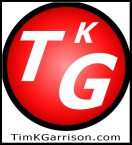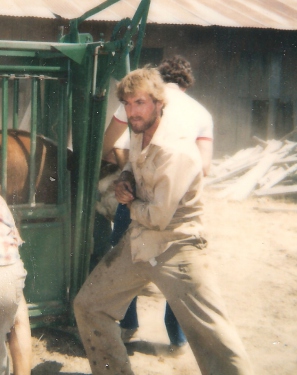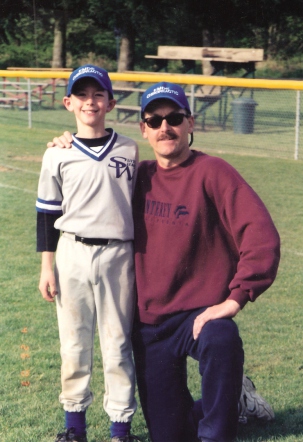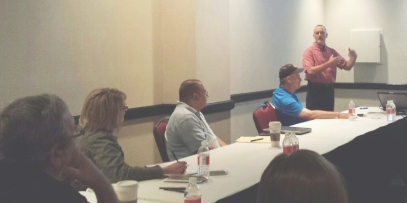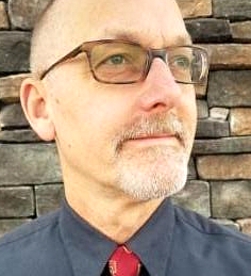
About Me
I currently live in Anacortes, WA with my wife, Cindy. You can contact me via this website.
There's undoubtedly more here than anyone cares to know but I include it for a couple reasons:
* I don't trust the web. This is the ONLY place to get the true scoop.
* Our world is based on relationships. The more we know a person, the more likely we are to trust them. Trust is the basis for all relationships. Relationships are the basis for all business.
My folks bought a 76-acre ranch where we moved when I was nine.
That's where I grew up and I'm mighty proud of it. It's where I learned how to work and to innovate. We were poor, so when something broke either we fixed it or went without. I learned carpentry, welding, auto mechanics, and a host of other useful stuff.
Photo: Framing our house. Brother Mark in the foreground. My family built the house ourselves, paying as we went. It was finished when I'd moved away to college - bummer.
College
My older brother, Kurt, and I rented a little bungalow while we attended Modesto Jr. College. In '81 I graduated with an A.S. in Architectural Engineering.
I thought I wanted to be an architect but couldn't get accepted at Cal Poly and so on the advice of a prof., Leroy Holmes, I decided on civil engineering. One of the better choices I've ever made.
Professor Holmes also suggested I attend Sacramento State because they had a good C.E. program and I should be able to find work in my field there. I preferred the much sexier Chico State but, again, took my prof's advice and the conservative route at Sac State.
Photo: Graduation, 1984, Sacramento State with my Mom, Jan. Photobomb - brother Mark.
Holmes knew what he was talking about. While at Sac State I worked as a carpenter. Then, junior year I landed a job at a truss manufacturing design office. Senior year my roommate, Don Brafford, a Native American, said I should check out an internship with the U.S. Indian Health Service (IHS) designing water and wastewater facilities. While not my first choice of engineering disciplines, I needed the money so applied and got the internship. This would result in my first real job upon graduation.
Indian Health Service (IHS)
In '84 I graduated Tau Beta Pi with a bachelor degree in civil engineering. I packed a few meager belongings into my '71 Datsun pickup and headed south, all the way to Fresno. There was an opening for IHS field engineer there for which I applied and got. I was suddenly in charge of a 3-person office, including: a part-time secretary, a full-time field technician, and me. I had a backhoe, dump truck, pickup truck, office, people and a million dollar budget. My nearest supervisor was 175 miles away in Sacramento. Whoa - at age 24, green as a gourd, this was a challenge.
My "office" was a single-wide mobile home parked on the tarmac of FAT (Fresno Air Terminal.) My first summer, the daytime temperature soared to over 100-degrees for three straight months, except three days it only reached the mid-90s. My "office" had a cheesy window-mounted air conditioner which when trained full-blast directly on my desk cooled my space to a balmy 95-degrees. It was annoying to lay my arms on the desk because any papers scattered there would stick.
Photo: IHS Regional Engineer, circa 1986. This photo was taken a couple of years into the job. By this time I'd moved my office from the singlewide on the tarmac of FAT to a an actual decent office shared with the federal motor pool near downtown Fresno.
My work with IHS involved designing and installing water and wastewater facilities for Native Americans. I had some 50 communities to serve from Porterville to Yosemite. After three years I knew this wasn’t my calling and went looking for something different.
California Water Quality Control Board
I found the California Water Quality Control Board, a regulatory agency overseeing wastewater dischargers. Now I was a water quality cop. My job was to inspect wastewater plants and then report on their shortcomings and violations. It didn't take me long to figure out this was not for me. I like to build stuff, get things done. Regulatory agencies are sort of the opposite - telling people what they can't do. I lasted 8 months and then bolted to another state agency.
Marriage and More School
About this time I married Kelly Peterson - a Fresno native. I was pretty bored in Fresno, so enrolled in night classes at Fresno State.
My marriage started out rocky and only got worse. After two years we divorced. Fortunately no kids were involved. About that time I wrapped up studies at Fresno State with a master’s degree in civil engineering. Other than my job, now there wasn’t much keeping me in Fresno – I had no family there and wasn’t so fond of the weather nor air quality.
California Department of Forestry and Fire Protection (CDF)
My move to CDF was a promotion. I went from one of 30 staff engineers in cubicles at the Water Quality Control Board to the CDF Region 4, Regional Engineer. Once again I had equipment, programs, budgets, and staff to oversee. Now this was more like it!
I supervised two engineers and a construction team who designed, built, and maintained fire stations, fire lookouts, communications towers, and conservation camps. (A conservation camp is a self-contained minimum security detention facility for low-risk offenders who the State uses to fight wildfires.) For the first time I was doing the full gamut of civil engineering: structural, water, wastewater, roads, and drainage.
Photo: CDF Regional Engineer Garrison with staff engineer Luke Serpa in foreground, Fresno, CA, circa 1989.
I liked my job but yearned for greener pastures, literally – it’s pretty brown in Fresno. I almost took a job with the City of Sonora, but just before committing a transfer position in CDF came up in Sacramento, which I jumped on. It was a lateral move but now I was doing engineering for CDF on a statewide scale, from Oregon to Mexico.
Now back in my college stomping grounds I reconnected with an old college buddy, Mike Ruthford, who was working for the Army Corps of Engineers. Mike, his brother, Brian, and I took a couple road trips to western Washington to visit their folks who lived in La Conner. I was enchanted with the area – so green and lush, with clean air and lots of water. Mike’s dad, Mike Sr., had been a globe-trotting civil / structural engineer with Bechtel Corp., was now “retired” and a partner in a construction company in Sedro-Woolley. Over pizza and beer we mused how cool it would be to start our own company in WA.
Seeds of the Private Sector
Where there’s a will, there’s a way. Those pizza and beer discussions expanded and soon it would become a reality. We laid plans for a start-up construction / engineering company in La Conner, WA. There would be three principals: Mike Ruthford Sr., Don Wilkins, and me. Ironically, Mike Jr. opted out but his brother, Brian, was in – as our controller. Mike and Don, some 20 years my senior, were both PEs (Professional Engineers), and wanted to do construction only. I was fine with construction or engineering, whatever it took to pay the bills.
Marriage Two – Getting It Right
While in Sacramento I met Cindy Williams, a fellow Sac State grad and West Sacramento native. We dated for a year and then married. Two days after the ceremony we packed up a U-Haul and headed north. The honeymoon wasn’t much to brag about but the gal surely was. As I write this we’ve been married 25 wonderful years and look forward to 25 more.
Crest Inc.
Any startup is difficult, but it was 1992, a recession year. What few jobs there were always saw ten or more bidders. The frustration of coming in 2nd time and again was unbearable. We were desperate for revenue so I hung out an engineering shingle and took whatever straggled through the door. We survived.
Photo: Startup at Crest, Inc. Doing whatever it takes. Me in foreground finishing a driveway. Foreman, Dan Manville in background.
After a couple of Spartan years Mike and Don proposed a move from our rented space to an old converted stove factory in a nearby town that they wanted to purchase. I wasn't so enthusiastic and was seriously disillusioned with construction. So I sold out and started my own engineering company in nearby Mt. Vernon: Garrison Engineering Corp, or G. Corp. for short. My split with Crest was amicable – to this day I still hang out with Mike Sr. and Brian and do their engineering.
G. Corp.
Now I was in startup mode again. At least I’d made a few contacts and had some clients. My work was a good mix of civil and structural. I hired a planner, a draftsman and an EIT (Engineer in Training) named Robert MacKay.
Photo: Brothers Tim and Carl Garrison, Mount Vernon, WA, circa 1995.
My younger brother, Carl, a mechanical engineer, was working for a large cannery in Modesto, CA at the time. I asked him if he wanted to venture north and join me. He said yes, joined as a partner, and took charge of our water systems and HVAC design programs.
Skagit Surveyors and Engineers
The one thing we lacked was surveying capability. In a twist of fate, a surveyor in nearby Sedro-Woolley had just lost their engineer. Their two owners, and Carl and I created an umbrella LLC called Skagit Surveyors and Engineers, with G. Corp. and Skagit Surveyors as members. We moved into their building in ‘95. This arrangement worked reasonably well for five years, during which time we would complete 150+ civil, structural, and mechanical jobs a year and grow to ten employees.
Photo: G. Corp staff, from left: Marianne Manville-Ailles, Rob MacKay, Carl Garrison, Cindy Garrison, me, Todd Pote. This was the engineering component of Skagit Surveyors and Engineers, 1995-2000.
Up to this point I was a typical engineer, doing things the way most other engineers did them. I was young, inexperienced and didn’t have a mentor or business coach. Everything Carl and I did, we winged it. We purchased software and hardware based on our best guess. Like all other firms in this era of rapidly evolving computers and software, we wasted a ton of money and time chasing that ever-elusive holy grail of technology.
Rob MacKay – Excel Guru
But we had a secret weapon: our young engineer in training: Rob MacKay. Before hiring him I checked his references – he only had two: his previous employer at a timber frame joinery and a prof at Portland State. The prof told me, “it’s not whether you select him, it’s whether he selects you.” Whoa – that’s about as good as a referral gets. And it turned out to be true. If I have one regret in business it’s that I let Rob get away.
Anyway, soon after hiring Rob I noticed that he was doing calcs with Excel spreadsheets. This was 1995. I barely knew what a spreadsheet was, let alone know how to operate one. I was using store-bought software that didn’t work well, cost too much money, and generally caused more consternation than help. Rob developed structural spreadsheets at home in his spare time. He’d show me output from them like I should understand what I was seeing because I was the “senior” engineer.
After a few years of this, it became clear that Rob’s spreadsheets were superior to any commercial software I could buy. And if I liked them so well, why wouldn’t everyone else in the world?
As 2000 approached I was souring on the LLC we’d created five years earlier. It was tough being in business with your brother, and serious incompatibilities with my surveyor partners had surfaced. It was time for a change.
I told Carl that I wanted out, and offered to basically give him G. Corp. All I wanted in return was Rob, his spreadsheets and one other employee. Carl reluctantly agreed - his main interest was mechanical engineering, not spreadsheets or structural analysis. We went ahead with the split. For a year or so afterward we experienced some strain but time healed all. We’ve since enjoyed a terrific working and family relationship. Carl might not agree but in my opinion the split was the best thing we could have done.
ConstructionCalc
In 2000, my two employees, Rob MacKay and Ivan Kaliban, became my partners with the startup of yet another company: ConstructionCalc, Inc. Our strategy was that Ivan would do mostly engineering to pay the bills while Rob and I developed spreadsheets for sale. The timing was fortuitous because the internet was just coming into its own which solved a major distribution problem. We could open a virtual store at ConstructionCalc.com and sell software worldwide from our humble office in a converted house in Mount Vernon, WA.
Rob was the chief programmer and I wrote the manuals and on-board help tips. I was learning Excel at a rapid clip but was nowhere near Rob’s technical expertise. Within a year we had a suite of six structural engineering spreadsheets that we put up on a new website and began selling. Of course we used these programs ourselves in our engineering business, so we felt confident that they were accurate and awesome. And they were!
But the problem of marketing soon reared its obnoxious head. Just because you have a great product and a website visible to the world doesn’t mean the world will find you and buy. Now I had to learn about SEO, online marketing, pay per click, analytics, Google, etc. So I dove in and learned it. We optimized our website for search engines, advertised in trade magazines and spent a bundle on pay per click.
We made modest sales, which we tracked with pins on a U.S. map. As the months rolled by we delighted in the growing clusters of pins on our map: LA, Florida, New York, Houston. After a couple years we had at least one pin in each U.S. state, and pins in ten other countries. Pretty cool. But we were not bringing in that much cash.
I racked my brain for answers and came up with the idea that if people just understood better what we were about they’d buy. Our target market was engineers, architects, code officials, and builders. Maybe it was a stretch for non-engineers to really grasp our stuff?
Structural Concepts for the Non-Engineer
So I wrote, illustrated, and self-published my first book: Structural Concepts For the Non-Engineer. We sold it on our website and included it for free with every software sale. Still lackluster sales.
Disaster – 9/11
And then disaster struck: 9/11/01. The attack on the World Trade Centers plunged our local economy into a recession. Engineering work slowed to a trickle. We weren’t making nearly enough on software to sustain our five-person workforce. My two partners were becoming disillusioned with the software side. I still believed strongly in it, however, and wanted to keep pressing forward.
Several important things happened to me while trying to crack the software marketing nut:
* I found that I have a passion for writing.
* I began to wonder why I hadn’t become more successful in light of all that I’d done and how hard I’d worked.
* I found that I enjoy teaching.
* Regardless how much or little success ConstructionCalc software attained, I believed to my core that it’s a fantastic product with enormous potential.
From Employer to Employee
A client and personal friend, Robert Janicki, was doing land development and needed help managing his projects. We discussed the concept of me coming to work for him. I took the idea to my partners. By this time we’d laid off everyone but ourselves and still didn’t have enough work coming in to pay the bills. Rob and Ivan were not thrilled with the idea of splitting up, though they were weary of the software business and could see that the recession was taking a serious toll on our engineering side. They agreed to a split: I would take the software company and they’d take the engineering business. Rob and Ivan spun off their own engineering firm, West Coast Engineers, right down the road in Mount Vernon. I signed a two-year non-compete agreement with them and went to work full time for Rob Janicki.
For the next three years I mostly managed land development projects, with some in-house civil and structural engineering thrown in as needed.
Around 2005, Janicki’s projects hit a lull so I went to work for another local developer, Landed Gentry, doing pretty much the same things. This lasted until the great recession of 2008 at which point there wasn’t enough development going on to keep me busy.
The Builder's Engineer
I left Landed Gentry and went back to engineering but this time with no employees, working out of my home. I branded myself "The Builder's Engineer" and changed my website's name accordingly. It was a great move. After the recession construction gradually picked back up and so did my profitability. Every year since has been more successful than the previous.
Today I do about 100 engineering jobs per year and enjoy eviable success, as evidenced by five consecutive "best of" awards.
Creating and Selling Software Until 2018
After ten plus years of civil engineering and land development consulting I saw firsthand how many people misjudge the difficulty and risk in developing land – to their extreme detriment - many go broke. So I wrote an extensive white paper on the topic, and a proforma spreadsheet and began selling those from my website.
All the while I kept ConstructionCalc going, with a trickle of sales bringing in several thousand dollars a year – more than enough to cover costs. And I didn’t have to do much – most of the software was written. I pressed disks at my home office, printed labels, and mailed them. Over the next few years I had the website redone a couple times until I got frustrated with website developers and decided to do it myself. I set up a WordPress site and maintained it. After a few years of that I dumped WordPress for a better, low cost online website provider with integral shopping cart.
In 2018 I found that I did not have enough time to keep my software updated so rather than provide a sub-par product, I made the tough decision to pull the plug on ConstructionCalc. It was a great 15 year ride, taught me a ton about websites, software (Excel in particular) and I made a few bucks. I'm proud to say that I sold software in every U.S. state and 9 countries.
Youth Sports and the Sedro-Woolley Chainsaws
From ’02 – ’08, working a “regular” job, I had spare time that I didn’t as a business owner. My sons were in grade school and wanted to start organized sports. I recalled some of the best times of my life happened in Little League, especially when my dad was my coach. So I jumped into coaching youth sports with both feet: baseball, basketball, and soccer (irony: I never played basketball or soccer myself.) I would coach some 15 of my son’s teams over the next ten years. It was a highlight of my adult life. In scrimmages I’d let my teams make up names. Invariably it would be the Chainsaws vs. the Splitting Mauls.
Photo: Coach Dad with youngest son, Corey
I’ve always loved baseball and have been an ardent student of the sport. As my son went through the paces: Little League; Babe Ruth; select teams; private lessons; high school; junior college; and finally college, I paid attention. It was a massive learning experience, expensive, one for which I would have appreciated a resource along the way but never found. So with input from one of Connor’s select coaches, Pete Wilkinson, I wrote my own – a presentation entitled, My Kid Played For The Sedro-Woolley Chainsaws – Happily Navigating Little League, High School, and beyond.
PEARL – Passion, Effort, Ability, Risk, Luck
Around 2000 I took serious interest in success in business, searching for why I hadn’t been more successful. I’d certainly done the work, put in the time. I began reading books - biographies and business how-tos, starting with J. Paul Getty’s, How To Be Rich. Year after year my bookshelf expanded with tomes on success: Gladwell, Covey, Hershey, Disney, Schwarzenegger, Gerber, Jobs, Walton, Schwab, Aerosmith. I studied hundreds of books, articles, and documentaries. By 2014 I noticed patterns, similar things all successful people did. That summer as I fumbled with how best to organize what I’d learned it hit me. An epiphany. The five elements of all success form a perfect acronym: PEARL – Passion, Effort, Ability, Risk, and Luck. I wrote and published a book with that title.
I continue study of success to this day, still gulping down biographies: Welch, Tolkien, Lewis, Deming, Pyzdek and more. With each reference, my theory on PEARL gains validity.
The Collin Chronicles
Between work, coaching, and studying, I got the itch to write fiction. We lived on acreage at Big Lake, WA. I wanted to raise my sons in a rural environment like I had enjoyed. Our 55 acres of wooded hillside was a constant source of inspiration. The streams, meadows, beaver ponds, even a large waterfall sparked my imagination with a storyline that included my two sons as the main characters. In 2007 I finished writing and illustrating, and published a YA (Young Adult) novel, The Collin Chronicles – Book One – Magic, Bones, and Catacombs. It won two national awards. The other two books in the series are outlined, waiting for me to carve out time to finish them.
Writing For National Magazines
During this phase I also wrote hundreds of technical articles for various national magazines: NBN Online, Builder Magazine, Professional Builder Magazine, Journal of Light Construction, and others. For a year I even took the job of contributing editor for Builder Magazine, writing a series of how-to articles. I’d receive random emails of praise from editors and regular folks all over the U.S., which let me know that I was on to something.
Cracks, Sags, and Dimwits
I gathered 61 of my best articles, added illustrations, rewrote and edited them into a book, Cracks, Sags, and Dimwits – Lessons To Build On, published in 2005.
The Excel Programmer
All this time I was still selling software. Building codes change every three years which forced me to update my structural programs. But now Rob MacKay was gone – there was no one to do the programming but me. I bought books on Excel and VBA and tore into my programs, updating them, and also creating new ones.
Green Framing
Training and seminars are the first things to get chopped from most company’s budgets in a recession. In 2007, any hope of providing training dissolved. At that time, green construction was all the rage. Energy Star, sustainable design, etc. were in the news. I’ve always been a proponent of efficiency and finally the construction industry was in that frame of mind too. I took the clue and in 2010 wrote a book which parlayed my expertise as a consultant, software producer, and trainer: Green Framing – An Advanced Framing How-To Guide.
Business Consulting
In 2010 I noticed an author who published regularly in Professional Builder Magazine, Scott Sedam. His articles were all about lean construction – a topic of great interest to me. I reached out to him and he responded asking if I might be interested in joining his “lean team” of consultants. I said yes and over the next six years became the engineering expert on Scott’s team of consultants who travel to large builders, teaching them lean principles. I worked with some 30 companies from Pennsylvania, to Calgary, to Houston, to Los Angeles. Our thrust was the W. Edwards Deming idea of maximizing profit through elimination of waste. The American building industry is very fertile ground for this--waste has been a way of life since the industry began.
Helping other companies get lean and increase profit really turned my crank – I loved it. I could see a vast need for this sort of consulting throughout the construction industry. So in 2014 I took on a couple of clients as a business consultant / success coach. It’s been a terrific addition to my repertoire – an area that I will expand in the future.
On TV
My brother Mark owns a construction company in the San Jose / Gilroy, CA area, MG Constructors and Engineers. I've done most of his engineering over the years. Mark became acquainted with a local realtor, Pat Kapowich, who hosts a TV program dedicated to the residential real estate industry in the south bay area, Kapowich On Realty. Mark and I, a.k.a., The Garrison Brothers, have been his guests several times, tackling tough construction issues such as settlement, drainage, cracks, sags, permitting, etc.
Photo: Tim explaining a point to host Pat Kapowich as brother Mark leans in.
2022
Updating this on 2/22/22, are you still there? Amazing!
In 2017 Cindy and I downsized from 55 acres at Big Lake to a 9,000 square foot city lot in Anacortes, WA. I designed and built our new home, and we love it here. I work from an office in our house; a literal mom and pop business (Cindy does the books.) I still complete about 100 structural engineering jobs a year with a few lean consulting gigs here and there. I enjoy what I do so much there is no thought of retirement any time soon.
I guess after all I've been through you could call me a Toughnut. Attaboy/girl to anyone who can guess where this picture was taken.
